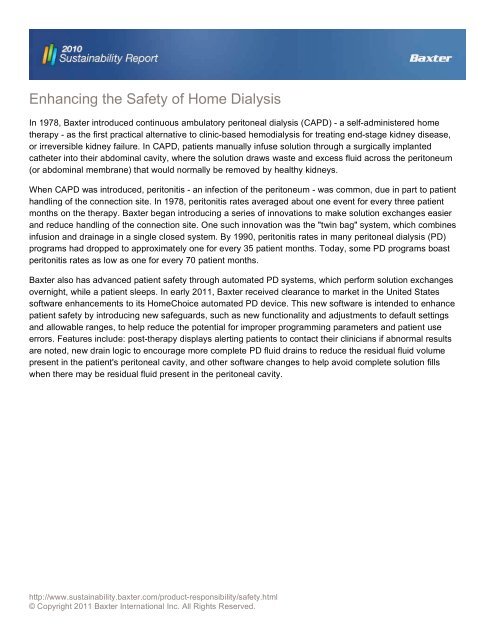Product Responsibility - Baxter Sustainability Report
Product Responsibility - Baxter Sustainability Report
Product Responsibility - Baxter Sustainability Report
- No tags were found...
Create successful ePaper yourself
Turn your PDF publications into a flip-book with our unique Google optimized e-Paper software.
Enhancing the Safety of Home DialysisIn 1978, <strong>Baxter</strong> introduced continuous ambulatory peritoneal dialysis (CAPD) - a self-administered hometherapy - as the first practical alternative to clinic-based hemodialysis for treating end-stage kidney disease,or irreversible kidney failure. In CAPD, patients manually infuse solution through a surgically implantedcatheter into their abdominal cavity, where the solution draws waste and excess fluid across the peritoneum(or abdominal membrane) that would normally be removed by healthy kidneys.When CAPD was introduced, peritonitis - an infection of the peritoneum - was common, due in part to patienthandling of the connection site. In 1978, peritonitis rates averaged about one event for every three patientmonths on the therapy. <strong>Baxter</strong> began introducing a series of innovations to make solution exchanges easierand reduce handling of the connection site. One such innovation was the "twin bag" system, which combinesinfusion and drainage in a single closed system. By 1990, peritonitis rates in many peritoneal dialysis (PD)programs had dropped to approximately one for every 35 patient months. Today, some PD programs boastperitonitis rates as low as one for every 70 patient months.<strong>Baxter</strong> also has advanced patient safety through automated PD systems, which perform solution exchangesovernight, while a patient sleeps. In early 2011, <strong>Baxter</strong> received clearance to market in the United Statessoftware enhancements to its HomeChoice automated PD device. This new software is intended to enhancepatient safety by introducing new safeguards, such as new functionality and adjustments to default settingsand allowable ranges, to help reduce the potential for improper programming parameters and patient useerrors. Features include: post-therapy displays alerting patients to contact their clinicians if abnormal resultsare noted, new drain logic to encourage more complete PD fluid drains to reduce the residual fluid volumepresent in the patient's peritoneal cavity, and other software changes to help avoid complete solution fillswhen there may be residual fluid present in the peritoneal cavity.http://www.sustainability.baxter.com/product-responsibility/safety.html© Copyright 2011 <strong>Baxter</strong> International Inc. All Rights Reserved.
















